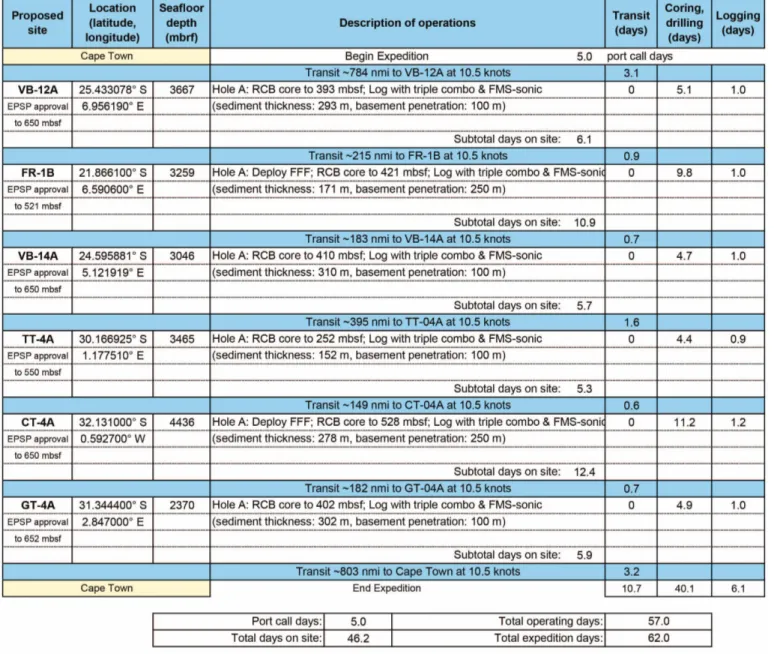International Ocean Discovery Program
Expedition 391 Scientific Prospectus Addendum
Walvis Ridge Hotspot: drilling Walvis Ridge, Southeast Atlantic Ocean, to test models of ridge-hotspot interaction,
isotopic zonation, and the hotspot reference frame
William Sager Co-Chief Scientist
Department of Earth and Atmospheric Sciences University of Houston
USA
Kaj Hoernle Co-Chief Scientist
Research Division 4: Dynamics of the Ocean Floor GEOMAR Helmholtz Centre for Ocean Research Kiel
Germany
Katerina Petronotis
Expedition Project Manager/Staff Scientist International Ocean Discovery Program
Texas A&M University USA
February 2021
This publication was prepared by the JOIDES Resolution Science Operator (JRSO) at Texas A&M University (TAMU) as an account of work performed under the International Ocean Discovery Program (IODP). This material is based upon work supported by the JRSO, which is a major facility funded by the National Science Foundation Cooperative Agreement Number OCE1326927. Funding for IODP is provided by the following international partners:
National Science Foundation (NSF), United States
Ministry of Education, Culture, Sports, Science and Technology (MEXT), Japan European Consortium for Ocean Research Drilling (ECORD)
Ministry of Science and Technology (MOST), People’s Republic of China Korea Institute of Geoscience and Mineral Resources (KIGAM)
Australia-New Zealand IODP Consortium (ANZIC) Ministry of Earth Sciences (MoES), India
Coordination for Improvement of Higher Education Personnel (CAPES), Brazil
Portions of this work may have been published in whole or in part in other IODP documents or publications.
This IODP Scientific Prospectus is based on precruise JOIDES Resolution Facility advisory panel discussions and scientific input from the designated Co-Chief Scientists on behalf of the drilling proponents. During the course of the cruise, actual site operations may indicate to the Co-Chief Scientists, the Expedition Project Manager/Staff Scientist, and the Operations Superintendent that it would be scientifically or operationally advantageous to amend the plan detailed in this prospectus.
It should be understood that any substantial changes to the science deliverables outlined in the plan presented here are contingent upon the approval of the IODP JRSO Director and/or JOIDES Resolu- tion Facility Board.
Disclaimer
The JRSO is supported by the NSF. Any opinions, findings, and conclusions or recommendations expressed in this material do not necessarily reflect the views of the NSF, the participating agencies, TAMU, or Texas A&M Research Foundation.
Copyright
Except where otherwise noted, this work is licensed under the Creative Commons Attribution 4.0 International (CC BY 4.0) license (https://creativecommons.org/
licenses/by/4.0/). Unrestricted use, distribution, and reproduction are permitted, provided the original author and source are credited.
Citation
Sager, W., Hoernle, K., and Petronotis, K., 2021. Expedition 391 Scientific Prospectus Addendum: Walvis Ridge Hotspot. International Ocean Discovery Program. https://doi.org/10.14379/iodp.sp.391add.2021
ISSN
World Wide Web: 2332-1385
W. Sager et al. Expedition 391 Scientific Prospectus Addendum
3
Introduction
This addendum to the International Ocean Discovery Program Expedition 391 Scientific Prospectus (Walvis Ridge Hotspot; Sager et al., 2020) incorporates minor coordinate changes to Proposed Sites CT-5A, CT-6A, TT-3A, TT-4A, TT-5A, VB-7A, VB-8A, VB- 10A, VB-11A, VB-13A, and VB-14A. The revised site coordinates are documented in Proposal 890-Add2, which is available at http://iodp.tamu.edu/scienceops/expeditions/wal-
vis_ridge_hotspot.html.
In addition, because of adjustments to the R/V JOIDES Resolu- tion operations schedule caused by the COVID-19 pandemic, the expedition was postponed by a year. At the time of publication of this addendum, the expedition is scheduled to start in Cape Town,
South Africa, on 6 December 2021 and end in Cape Town, South Africa, on 5 February 2022.
For a detailed description of the geologic background, scientific objectives, drilling and coring strategy, logging strategy, sample and data sharing strategy, and proposed sites, see Tables T1 and T2 in this report and the Expedition 391 Scientific Prospectus (Sager et al., 2020).
Reference
Sager, W., Hoernle, K., and Petronotis, K., 2020. Expedition 391 Scientific Pro- spectus: Walvis Ridge Hotspot. International Ocean Discovery Program.
https://doi.org/10.14379/iodp.sp.391.2020
4
Table T1. Operations plan and time estimates for primary sites, Expedition 391. EPSP = Environmental Protection and Safety Panel, RCB = rotary core barrel, FMS = Formation MicroScanner, FFF = free-fall funnel.
W. Sager et al. Expedition 391 Scientific Prospectus Addendum
5
Table T2. Time estimates for alternate sites, Expedition 391. EPSP = Environmental Protection and Safety Panel, FFF = free-fall funnel, RCB = rotary core barrel, FMS = Formation MicroScanner. (Continued on next two pages.)
6 Table T2 (continued). (Continued on next page.)
W. Sager et al. Expedition 391 Scientific Prospectus Addendum
7 Table T2 (continued).
